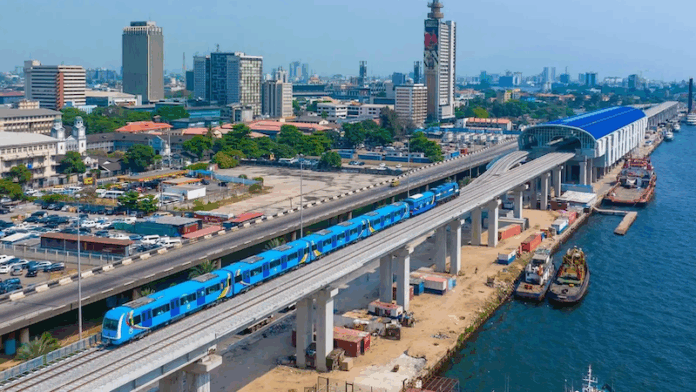Lagos, Nigeria’s bustling commercial capital, has long grappled with the challenges of urban mobility. Chronic traffic congestion, unreliable public transport, and environmental concerns have hindered the city’s growth. However, a transformative shift is on the horizon with the impending full-scale operation of the Blue Line rail system this June. This development promises to revolutionize commuting, offering a faster, more reliable, and environmentally friendly alternative to traditional road transport.
The Blue Line: A Vision Realized
The concept of a rail system in Lagos dates back to 1983, envisioned during the administration of Lateef Jakande. However, political upheavals and economic constraints delayed its realization. It wasn’t until 2009, under the leadership of Governor Babatunde Fashola, that serious efforts commenced with the establishment of the Lagos Rail Mass Transit (LRMT) project. The China Civil Engineering Construction Corporation (CCECC) was contracted to design and build the infrastructure.
The Blue Line, an electric-powered rapid transit system, is a pivotal component of the LRMT. Spanning 27 kilometers from Marina to Okokomaiko, the line is designed to operate on an exclusive right-of-way, ensuring no level crossings and minimal interference from other traffic. The first phase, covering 13 kilometers from Marina to Mile 2, commenced commercial operations in September 2023. The second phase, extending the line to Okokomaiko, is currently under construction and is expected to be completed by 2026.
Early Success and Growing Patronage
Since its partial launch in September 2023, the Blue Line has garnered significant attention and usage. By December 2024, the first phase had transported approximately 2.37 million passengers, reflecting a growing confidence in the system’s reliability and efficiency. The line operates five stations: Marina, National Theatre, Iganmu, Suru-Alaba, and Mile 2, with plans for additional stations in the second phase.
The trains are designed to run at a maximum speed of 80 km/h, with an average journey time of 35 minutes from end to end. The system operates on a fixed schedule, with trains running from 5:30 a.m. to 11:00 p.m., accommodating the peak commuting hours of Lagosians.
Infrastructure and Technological Innovations
The Blue Line’s infrastructure boasts several technological advancements aimed at enhancing safety and efficiency. The entire line operates on an exclusive right-of-way, eliminating level crossings and unauthorized access. The stations are equipped with modern amenities, including electronic ticketing systems, real-time train tracking, and accessible facilities for persons with disabilities.
The trains themselves are electric-powered, contributing to the state’s efforts to reduce carbon emissions and promote sustainable urban development. Additionally, the system integrates with other modes of public transport, such as buses and ferries, providing a seamless multi-modal transportation network for commuters.
Economic and Environmental Impacts
The introduction of the Blue Line is poised to have significant economic and environmental benefits. By providing a reliable alternative to road transport, the rail system is expected to reduce traffic congestion, leading to shorter travel times and increased productivity. Furthermore, the shift from diesel-powered vehicles to electric trains contributes to a decrease in air pollution, aligning with global sustainability goals.
Economically, the rail system is anticipated to create numerous jobs, both directly within the transit sector and indirectly through increased commerce and development around station areas. The improved connectivity is also expected to attract investments, fostering economic growth in previously underserved regions.
The Road Ahead: Challenges and Opportunities
While the Blue Line represents a significant advancement in Lagos’s transportation infrastructure, challenges remain. The completion of the second phase is critical to realizing the full potential of the system. Delays in construction, such as the need to demolish and reconstruct certain bridges to accommodate rail operations, have posed setbacks. However, the Lagos State Government, in collaboration with the CCECC, is committed to overcoming these obstacles and ensuring the timely completion of the project.
Looking forward, the success of the Blue Line serves as a model for future transportation projects in Nigeria and across Africa. The integration of modern technology, sustainable practices, and comprehensive planning can pave the way for other cities to develop efficient and environmentally friendly public transport systems.
Looking Ahead: The Future of Lagos’s Rail Network
As Lagos continues its journey towards a more connected and efficient urban transportation system, the expansion of its rail network stands as a testament to the city’s commitment to sustainable development and improved mobility.
Expansion of the Blue Line
The Blue Line, which commenced operations in September 2023, has already made significant strides in transforming the commuting experience for Lagosians. The initial phase, spanning 13 kilometers from Marina to Mile 2, has been instrumental in reducing travel times and easing traffic congestion. With the second phase underway, extending the line by an additional 14 kilometers to Okokomaiko, the Blue Line is poised to further enhance connectivity across the city. This extension is expected to be completed by 2027, bringing the total length of the Blue Line to 27 kilometers.
Introduction of the Red Line
Complementing the Blue Line, the Red Line is another critical component of Lagos’s rail infrastructure. Spanning 37 kilometers from Agbado to Oyingbo, the Red Line is designed to serve as a major north-south transit corridor. With eight strategically located stations, including Agbado, Iju, Agege, Ikeja, Oshodi, Mushin, Yaba, and Oyingbo, the Red Line is projected to move about 500,000 passengers daily upon full operation.
Future Rail Projects
Beyond the Blue and Red Lines, Lagos has ambitious plans to further expand its rail network:
- Green Line: A 68-kilometer line connecting Marina to the Lekki Free Trade Zone, aimed at serving the rapidly developing Lekki corridor.
- Purple Line: An 85.7-kilometer line from Redemption Camp to Ojo, designed to facilitate movement between Ogun State and Lagos.
- Yellow Line: A proposed line connecting Ota in Ogun State to the National Theatre in Lagos, enhancing inter-state connectivity.
- Orange Line: A 48-kilometer line from Ikeja to Agbowa-Ikosi, aimed at improving access to the northeastern parts of Lagos.
These projects are integral to the Lagos Strategic Transport Master Plan, which envisions a comprehensive and integrated transportation system to meet the city’s growing demands.


